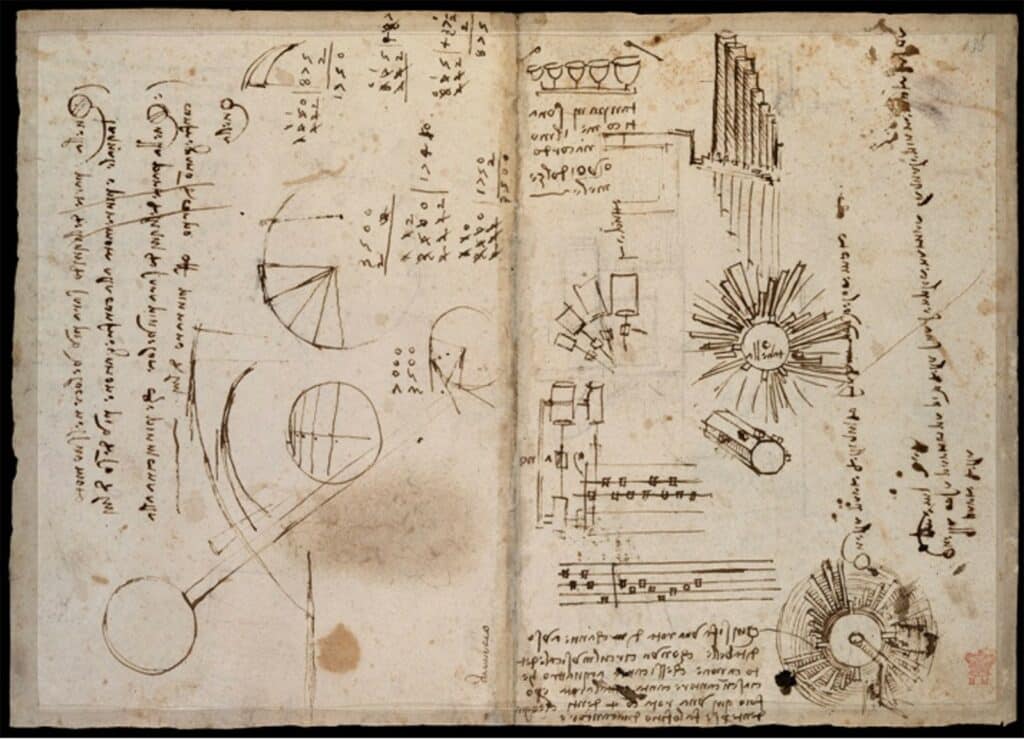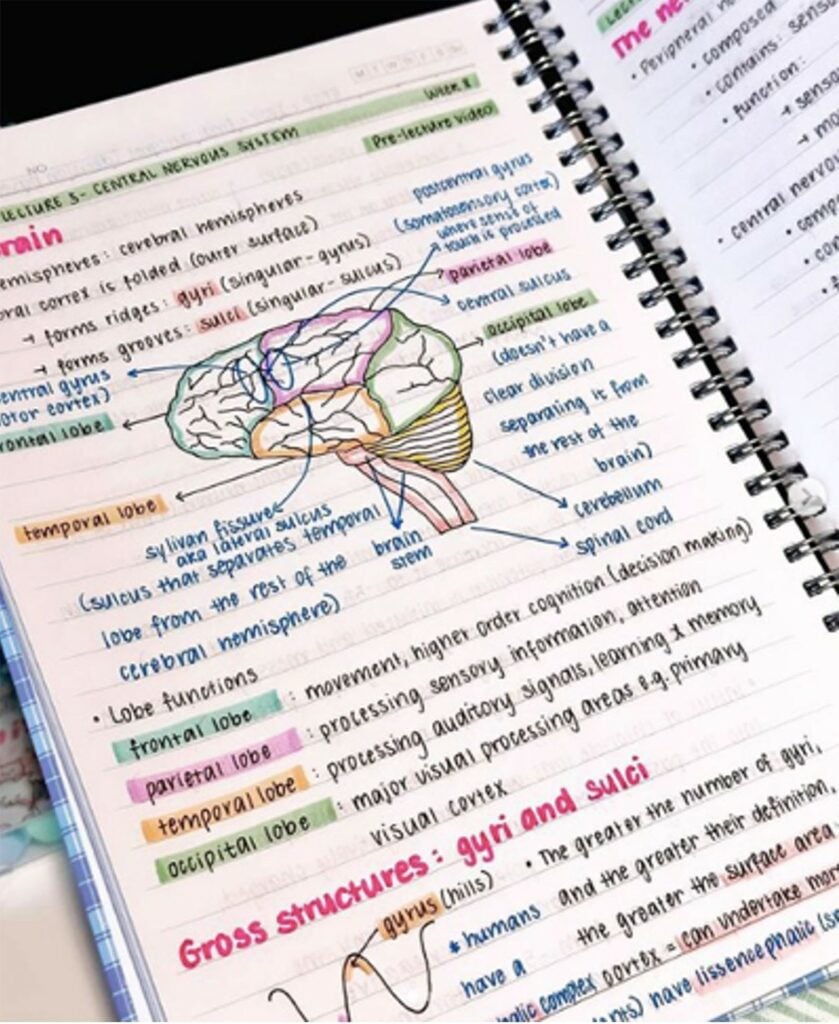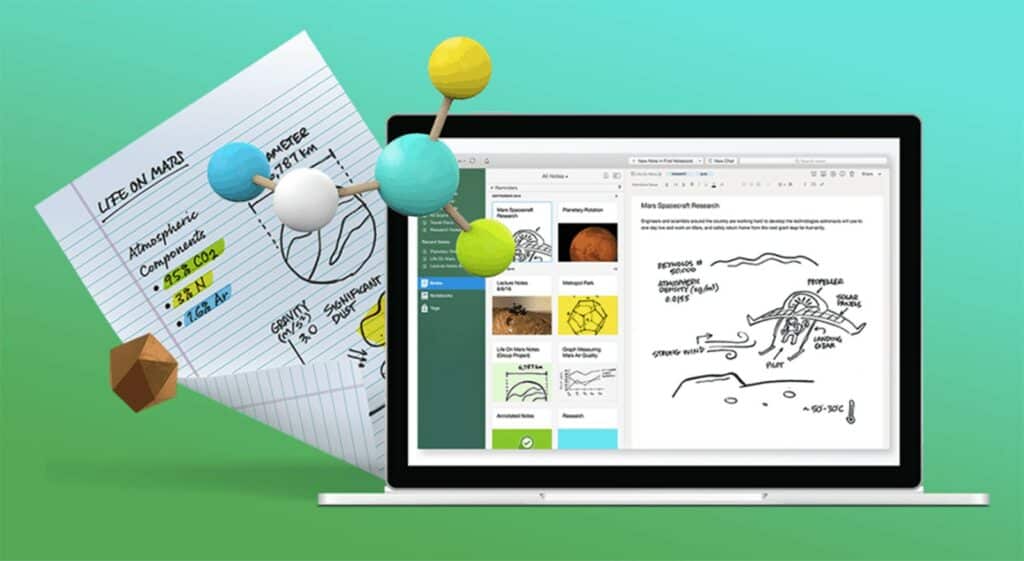- Aesthetic note-taking is the general approach of putting together words, images, color, typography, and other design elements to record and organize notes with visual appeal.
- Taking notes aesthetically can stimulate creativity and innovation and can facilitate learning comprehension and retention.
- Essential elements of an aesthetic note include images, diagrams, illustrations, and infographics. With these, you create visual cues that trigger memory recall and stimulate understanding.
- The use of color and typography plays a crucial role in enhancing not only the aesthetics of your notes but also the cognitive impact of information.
- By exploring creative layouts and design elements, you can visually organize your notes in any way that would work best for you and for the content.
- With the advent of tablets, smartphones, computers, and stylus pens, we now have access to a variety of digital platforms that can create the same design and functional elements of paper-based notes with added advantages.
Effective note-taking is a cornerstone of successful learning, aiding in understanding and retention of information. However, note-taking doesn’t have to be a mundane task limited to scribbles and bullet points.
Enter aesthetic note-taking—an approach that combines visual appeal with the art of learning. In this article, we’ll tell you all about aesthetic note-taking, exploring its benefits, techniques, and its unique ability to enhance both creativity and learning.
Table of Contents
What is aesthetic note-taking?
Traditional note-taking typically involves jotting down words and phrases on a blank page to record information that you want to remember, store, and share. Using pen and paper or digital devices, systematic note-taking has been proven essential for academic and professional work.
Aesthetic note-taking transforms this process into an art form. It is similar to visual note-taking – a technique that puts together words and images to record and organize notes. But aesthetic note-taking is more of a general approach – by incorporating colors, doodles, unconventional layouts, and creative typography, you make your notes “aesthetic” or visually appealing. Taking notes aesthetically can stimulate creativity and innovation. As you explore and experiment with your notes, your mind is free to wander and play with concepts. The tactile and visual approach to note-taking can also spark new ideas and associations, perfect for creative thinkers.
Moreover, the integration of artistic elements allows you to tap into your emotional and intuitive faculties, which are often overlooked in conventional note-taking. Why is this important? This holistic approach can help break down mental barriers, foster a more open and imaginative mindset, unveil new perspectives, facilitate innovative solutions, or simply give you an emotional outlet.
A classic example of an aesthetic note-taker is Leonardo da Vinci, the Renaissance polymath. His notebooks are filled with sketches, diagrams, and observations, offering a glimpse into the mind of a true creative genius. His fusion of art and science in his notes laid the foundation for groundbreaking discoveries and innovations.

Adding visual cues to your notes
Images
Incorporating relevant images into your notes can provide context and make abstract concepts more tangible. For example, if you’re studying biology, drawing images of cells or organisms alongside your notes can help you better grasp the subject matter.

Diagrams
Diagrams are excellent for illustrating processes, hierarchies, and relationships between concepts. Flowcharts, Venn diagrams, and concept maps are valuable tools for organizing information visually. When you draw a diagram during a lecture or while reviewing, you’re not just copying information but actively engaging with it.

Illustrations
Creating your own illustrations or sketches can be a powerful way to internalize complex ideas. Whether it’s a visual representation of a historical event or a graph depicting statistical data, your personalized illustrations can serve as mnemonic devices to trigger memory recall.

Infographics
Infographics are visual representations that distill data and concepts into a digestible format. It blends text, images, and graphics to convey information efficiently. In the context of note-taking, you can create and encapsulate the key points of a lecture or reading assignment in a single, visually engaging infographic (which is often the end product of visual note-taking). The act of designing infographics enhances your summarization and synthesis skills, promoting a deeper understanding of the subject matter.

Incorporating color and typography
The use of color and typography plays a crucial role in enhancing not only the aesthetics of your notes but also the cognitive impact of information. While the content of your notes is crucial, the way you format and present them can also help organize data.
First, you need to understand that colors have a profound impact on our emotions, perceptions, and cognitive processes. This phenomenon is known as color psychology. Different colors evoke different feelings and can influence how we interpret information. Here are a few color associations:
- Red: Often associated with urgency and excitement, red can grab attention and convey importance. It is a great choice for highlighting key points or critical information.
- Blue: Blue is often seen as calm and trustworthy. Using blue in your notes can help create a sense of reliability, making it an excellent choice for summarizing essential concepts or key takeaways.
- Green: Green symbolizes growth and balance. Incorporating green into your notes can help emphasize positive and balanced aspects of the content, such as solutions or benefits.
- Yellow: Yellow is bright and attention-grabbing. Use it sparingly to draw attention to essential details such as dates, deadlines, or to-do items.
Understanding these color associations can help you choose the right colors to convey the intended message and emotions in your design. But when taking notes, remember that you are using color to organize and categorize information and to make complex data more accessible – especially important to keep in mind when highlighting notes. Here’s how you can effectively use color to visually separate and distinguish different types of information with your notes:
- Categories: Assign specific colors to different categories or topics within your notes. For example, use red for definitions, blue for examples, and green for additional explanations.
- Key Concepts: Highlight key concepts for important points with a specific color to make them easily identifiable when you review your notes later.
- Visual Hierarchy: Create a hierarchy within your notes by using varying colors to denote the importance or relevance of each piece of information. This hierarchy can help you quickly locate and focus on critical details.
When using color coding in your notes, it is essential to maintain consistency. Unless it is meaningful, avoid making your notes too colorful, as it can affect the overall aesthetic and also the functionality of your notes.

Typography is the science of using letter forms for different hand-written, printed, or digital communication. It plays a crucial role in ensuring that your notes are not only readable but also aesthetically pleasing. Here are some typography considerations for note-taking:
- Readability: Choose fonts that are easy to read, both in print and on screens. Sans-serif fonts like Arial and Helvetica are commonly used for digital notes. When writing notes by hand, you may use whatever style you are most comfortable with — cursive or print. What is important is that you write neatly, legibly, and consistently.
- Hierarchy: Establish a clear typographic hierarchy by using different font sizes. These variations can indicate headings, subheadings, and body text.
- Formatting: Emphasize important information with formatting options such as bold, italics, or underline. These formatting choices help draw attention to key points within your notes.
- Consistency: Maintain consistency in your typography choices throughout your notes to create a clean and organized look. Consistency enhances readability and aesthetics.

Creative layouts and design elements
- Grids and Columns: Using different grid and column layouts can give your notes a structured and organized appearance and enhance your note’s visual appeal.
- Mind Maps and Flowcharts: Visual thinkers often benefit from mind maps and flowcharts because these mirror the way the brain naturally processes These layouts help you connect ideas and concepts in a visually engaging way, making it easier to grasp complex information.
- Storyboards: Use storyboards to create a visual narrative within your notes. This technique is ideal for summarizing events, timelines, or processes, and it can make your notes more engaging and memorable.
- Bullet Journal Format: The bullet journaling technique involves using symbols such as dots, squares, and circles to categorize tasks and notes. It also involves creating pages for indexing, future planning, and tracking habits. Implementing this system helps you prioritize and organize your thoughts efficiently.

Adding decorative elements such as dividers, frames, and doodles can breathe life into your notes and transform them into personalized works of art.
- Dividers: Insert decorative dividers between sections or topics to separate content visually. Aside from adding aesthetic appeal, it also aids in navigation.
- Frames and Borders: Use frames or borders to highlight important information and quotes. A well-placed frame can draw attention to key points in your notes.
- Doodles and Illustrations: Incorporate doodles and illustrations to personalize your notes and make them more engaging. Simple sketches or icons can represent ideas and concepts effectively.
Integrating technology and digital tools
- Infinite Space: One of the primary benefits of digital note-taking is the virtually unlimited space available. You can create as many pages or notebooks as needed without worrying about running out of physical paper. This is especially useful for long lectures, research projects, or extensive study materials.
- Multimedia Integration: Digital notes allow for seamless integration of multimedia elements. You can embed images, videos, audio clips, and hyperlinks directly into your notes. The multimedia integration enhances comprehension and retention, making notes more interactive and engaging.
- Searchable Content: Digital notes are easily searchable, saving time when revisiting information. Most note-taking apps and software provide powerful search functionalities, enabling you to quickly locate specific keywords or topics within your notes.
- Cloud Synchronization: Many digital note-taking tools offer cloud synchronization, ensuring that your notes are accessible from various devices. This flexibility enables users to switch between devices without losing their work.
- Notion: Notion is a versatile productivity tool that allows users to create notes, databases, and websites within the same platform. Its customizable templates and rich text editing capabilities make it a great choice for aesthetically pleasing notes.

- Evernote: Evernote offers a range of formatting options and the ability to attach files and images. Its tagging system and note organization features can help you keep your notes neatly arranged. It has a library of templates suitable for different learning styles. These notes are even shareable with fellow students.

- OneNote: Microsoft OneNote offers a digital notebook experience, complete with various formatting tools, drawing options, and seamless integration with other Microsoft Office apps. It is particularly useful for students and professionals who work within the Microsoft ecosystem.

Practical Tips for Getting Started with Aesthetic Note-taking
1. Understand your learning style, goals, and preferences. Before starting out with your aesthetic note-taking, it is important to understand your personal learning and note-taking preferences.
- Learning Style: Determine your primary learning style. Are you a visual learner who benefits from colorful diagrams and illustrations? Or do you lean towards text-based notes? Knowing this will guide your aesthetic design choices.
- Note-taking Goals: Consider the purpose of your notes. Are you taking notes to study, organize thoughts, or simply document information? Clarity about your objectives will help you tailor your note-taking style accordingly.
- Medium Preference: Decide whether you prefer digital or analog note-taking. Digital tools offer endless design possibilities, while analog methods like bullet journaling and drawing provide a tactile experience.
2. Balance aesthetics and functionality. It is crucial to strike a balance between aesthetics and functionality to ensure that your notes remain effective tools for learning and communication.
- Legibility: Ensure that your text remains legible. Choose fonts and font sizes that are easy to read. Avoid overly decorative or cursive fonts that might hinder comprehension.
- Contrast: Use appropriate color contrast to make text and visuals stand out. High contrast between text and background is essential for readability.
- Consistency: Maintain consistency in your note-taking style. Consistent use of symbols, icons, and color-coding will help viewers understand your notes better.
- Relevance: Include only the decorative elements that add value to your notes. Over-decorating can clutter your notes and distract you from the content.
- Visual Hierarchy. Establish a clear visual hierarchy within your notes. Use formatting and design elements to highlight key points and important information.
- Minimalism. Embrace minimalism when necessary. Sometimes, less is more. Avoid overloading your notes with too many visuals or decorations.
- Feedback and Iteration. Seek feedback from others to evaluate the practicality of your notes. Iteration is a crucial part of achieving the right balance between style and functionality.

3. Be versatile. The beauty of aesthetic note-taking lies in its versatility. Experiment with the various aesthetics and styles discussed earlier to find out what’s best for you. Practice regularly and dedicate time to experimenting with new styles and techniques in your notes. You may also use online resources like Pinterest or Instagram to get note-taking inspirations and to post your own aesthetic notes for your own and shared learning.




